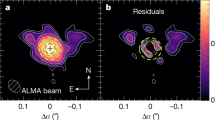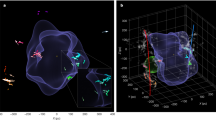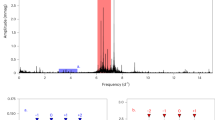Abstract
Convection plays a major part in many astrophysical processes, including energy transport, pulsation, dynamos and winds on evolved stars, in dust clouds and on brown dwarfs1,2. Most of our knowledge about stellar convection has come from studying the Sun: about two million convective cells with typical sizes of around 2,000 kilometres across are present on the surface of the Sun3—a phenomenon known as granulation. But on the surfaces of giant and supergiant stars there should be only a few large (several tens of thousands of times larger than those on the Sun) convective cells3, owing to low surface gravity. Deriving the characteristic properties of convection (such as granule size and contrast) for the most evolved giant and supergiant stars is challenging because their photospheres are obscured by dust, which partially masks the convective patterns4. These properties can be inferred from geometric model fitting5,6,7, but this indirect method does not provide information about the physical origin of the convective cells5,6,7. Here we report interferometric images of the surface of the evolved giant star π1 Gruis, of spectral type8,9 S5,7. Our images show a nearly circular, dust-free atmosphere, which is very compact and only weakly affected by molecular opacity. We find that the stellar surface has a complex convective pattern with an average intensity contrast of 12 per cent, which increases towards shorter wavelengths. We derive a characteristic horizontal granule size of about 1.2 × 1011 metres, which corresponds to 27 per cent of the diameter of the star. Our measurements fall along the scaling relations between granule size, effective temperature and surface gravity that are predicted by simulations of stellar surface convection10,11,12.
This is a preview of subscription content, access via your institution
Access options
Access Nature and 54 other Nature Portfolio journals
Get Nature+, our best-value online-access subscription
$29.99 / 30 days
cancel any time
Subscribe to this journal
Receive 51 print issues and online access
$199.00 per year
only $3.90 per issue
Buy this article
- Purchase on Springer Link
- Instant access to full article PDF
Prices may be subject to local taxes which are calculated during checkout



Similar content being viewed by others
References
Giménez, Á . et al. (eds) ASP Conf. Ser. Vol. 173 (ASP, 1999)
Kupka, F. Convection in stars. In Proc. IAU Symp. Vol. 224 (eds Zverko, J. et al.) 119–129 (Cambridge Univ. Press, 2004)
Schwarzschild, M. On the scale of photospheric convection in red giants and supergiants. Astrophys. J. 195, 137–144 (1975)
Wittkowski, M. et al. Aperture synthesis imaging of the carbon AGB star R Sculptoris: detection of a complex structure and a dominating spot on the stellar disk. Astron. Astrophys. 601, A3 (2017)
Young, J. S. et al. New views of Betelgeuse: multi-wavelength surface imaging and implications for models of hotspot generation. Mon. Not. R. Astron. Soc. 315, 635–645 (2000)
Haubois, X., Perrin, G. & Lacour, S. Imaging the spotty surface of Betelgeuse in the H band. Astron. Astrophys. 508, 923–932 (2009)
Montargès, M. et al. The close circumstellar environment of Betelgeuse. IV. VLTI-PIONIER interferometric monitoring of the photosphere. Astron. Astrophys. 588, A130 (2016)
Keenan, P. C. Classification of the S-type stars. Astrophys. J. 120, 484–505 (1954)
Mayer, A. et al. Large-scale environments of binary AGB stars probed by Herschel. II. Two companions interacting with the wind of π1 Gruis. Astron. Astrophys. 570, A113 (2014)
Freytag, B., Holweger, H., Steffen, M. & Ludwig, H.-G. in Science with the VLT Interferometer (ed. Paresce, F. ) 316–317 (Springer, 1997)
Tremblay, P.-E. et al. Granulation properties of giants, dwarfs, and white dwarfs from the CIFIST 3D model atmosphere grid. Astron. Astrophys. 557, A7 (2013)
Trampedach, R. et al. A grid of three-dimensional stellar atmosphere models of solar metallicity. I. General properties, granulation, and atmospheric expansion. Astrophys. J. 769, 18 (2013)
Le Bouquin, J.-B. et al. PIONIER: a 4-telescope visitor instrument at VLTI. Astron. Astrophys. 535, A67 (2011)
Baron, F., Monnier, J. D. & Kloppenborg, B. A novel image reconstruction software for optical/infrared interferometry. Proc. SPIE 7734, 77342I (2010)
Thiébaut, É. MIRA: an effective imaging algorithm for optical interferometry. Proc. SPIE 7013, 70131I (2008)
Kervella, P. et al. The close circumstellar environment of Betelgeuse. II. Diffraction-limited spectro-imaging from 7.76 to 19.50 μm with VLT/VISIR. Astron. Astrophys. 531, A117 (2011)
Wedemeyer-Böhm, S. & Rouppe van der Voort, L . On the continuum intensity distribution of the solar photosphere. Astron. Astrophys. 503, 225–239 (2009)
Freytag, B. & Höfner, S. Three-dimensional simulations of the atmosphere of an AGB star. Astron. Astrophys. 483, 571–583 (2008)
Freytag, B., Liljegren, S. & Höfner, S. Global 3D radiation-hydrodynamics models of AGB stars. Effects of convection and radial pulsations on atmospheric structures. Astron. Astrophys. 600, A137 (2017)
Ulrich, R. K. Convective energy transport in stellar atmospheres. I: a convective thermal model. Astrophys. Space Sci. 7, 71–86 (1970)
van Leeuwen, F. Validation of the new Hipparcos reduction. Astron. Astrophys. 474, 653–664 (2007)
Ludwig, H.-G. et al. The CIFIST 3D model atmosphere grid. Mem. Soc. Astron. Ital. 80, 711–714 (2009)
Bordé, P., Coudé du Foresto, V., Chagnon, G. & Perrin, G. A catalogue of calibrator stars for long baseline stellar interferometry. Astron. Astrophys. 393, 183–193 (2002)
Lafrasse S. et al. Building the ‘JMMC Stellar Diameters Catalog’ using SearchCal. Proc. SPIE 7013, 77344E11 (2010)
Renard, S., Thiébaut, E. & Malbet, F. Image reconstruction in optical interferometry: benchmarking the regularization. Astron. Astrophys. 533, A64 (2011)
Baron, F ., Monnier, J ., Young, J . & Buscher, D. New theoretical frameworks for interferometric imaging. ASP Conf. Ser. 487, 229–236 (2014)
Van Eck, S. et al. A grid of MARCS model atmospheres for late-type stars. II. S stars and their properties. Astron. Astrophys. 601, A10 (2017)
Paladini, C. et al. The VLTI/MIDI view on the inner mass loss of evolved stars from the Herschel MESS sample. Astron. Astrophys. 600, A136 (2017)
Acknowledgements
C.P. acknowledges the support of the Fonds National de la Recherche Scientifique (F.R.S.-FNRS), Belgium. C.S., G.S. are supported by the PRODEX office, Belgium. This research has been funded by the Belgian Science Policy Office under contract BR/143/A2/STARLAB (S.S., A.J., S.V.E.). K.K. is supported by a FRIA grant (Belgium). F.B. acknowledges funding by the National Science Foundation, NSF-AST numbers 1445935 and 1616483. J.K. acknowledges the Philip Leverhulme Prize (PLP-2013-110). S.V.E. thanks the Fondation ULB for its support. The research leading to these results has received funding from the European Union’s Horizon 2020 research and innovation programme under Grant Agreement 730890 (OPTICON) and from the Austrian Science Fund (FWF) under project AP23006-N16. We thank all the ESO/VLTI staff for supporting our observations.
Author information
Authors and Affiliations
Contributions
This project was initiated by C.P. A.M. carried out the observations. J.B.L.B. performed the data reduction, F.B. and J.B.L.B. performed the image reconstruction. The contrast and the PSD analysis was carried on by C.P., B.F. and F.B. The stellar parameter determination was made by C.P., S.V.E., S.S., and K.K. A.J. gave crucial help through all the scientific analysis. The text was written by C.P., F.B. and A.J., and edited by the other authors that contributed to the scientific discussion.
Corresponding author
Ethics declarations
Competing interests
The authors declare no competing financial interests.
Additional information
Reviewer Information Nature thanks P. Kervella, J. Young and the other anonymous reviewer(s) for their contribution to the peer review of this work.
Publisher's note: Springer Nature remains neutral with regard to jurisdictional claims in published maps and institutional affiliations.
Extended data figures and tables
Extended Data Figure 1 The PIONIER data.
The upper left panel shows in black the PIONIER squared visibilities V and in blue the Fourier transform of the SQUEEZE image (first spectral channel) on a linear (main panel) and semi-logarithmic (inset) scale. The upper right panel is the same, but for the closure phase. The lower left panel shows the u–v coverage of the data. The blue data correspond to observations acquired with the short VLTI array configuration (called ‘A1-B2-C1-D0’). The red data correspond to observations acquired with the intermediate array configuration (‘D0-G1-H0-I1’).
Extended Data Figure 2 SQUEEZE images and error images.
a–c, The first row of images corresponds to the adopted SQUEEZE images; the second row, labelled ‘+STD DEV’, corresponds to images one standard deviation above the average image; and the third row of images, labelled ‘-STD DEV’ shows images one standard deviation below the average image.
Extended Data Figure 3 Spectral energy distribution.
Comparison between the spectral energy distribution (yellow stars) and the best-fitting MARCS synthetic spectrum (black line). Note the presence of a moderate infrared excess longwards of 10 μm (105 Å) attributable to circumstellar dust.
Rights and permissions
About this article
Cite this article
Paladini, C., Baron, F., Jorissen, A. et al. Large granulation cells on the surface of the giant star π1 Gruis. Nature 553, 310–312 (2018). https://doi.org/10.1038/nature25001
Received:
Accepted:
Published:
Issue Date:
DOI: https://doi.org/10.1038/nature25001
This article is cited by
-
Signatures of convection in the atmospheres of cool evolved stars
Living Reviews in Computational Astrophysics (2024)
-
Atmospheric molecular blobs shape up circumstellar envelopes of AGB stars
Nature (2023)
-
Astrophotonics: astronomy and modern optics
The Astronomy and Astrophysics Review (2021)
-
A glimpse inside δ Scuti stars
Nature (2020)
-
Why chromatic imaging matters
Experimental Astronomy (2018)
Comments
By submitting a comment you agree to abide by our Terms and Community Guidelines. If you find something abusive or that does not comply with our terms or guidelines please flag it as inappropriate.



